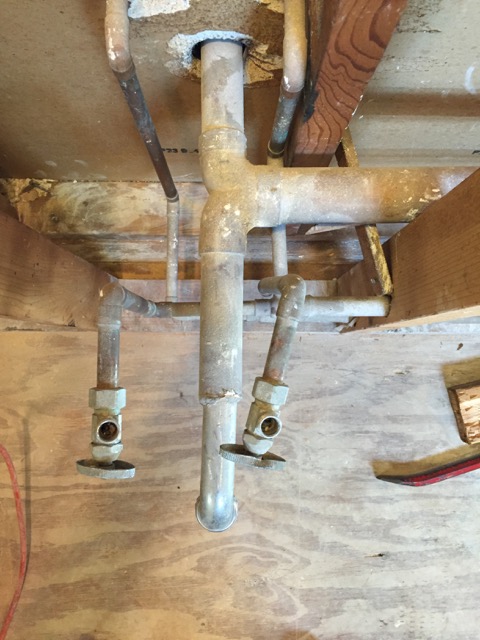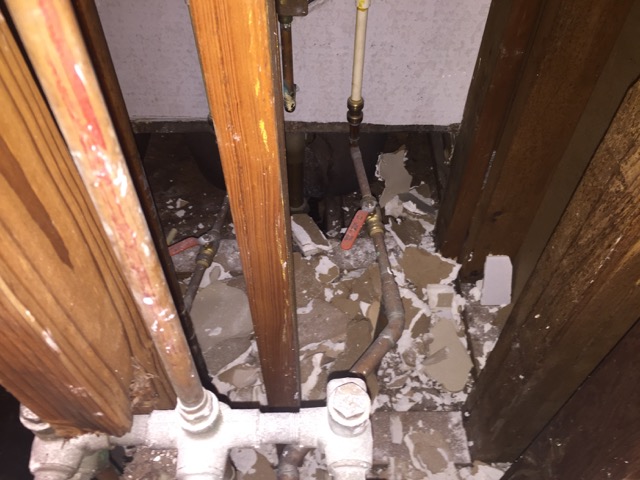
Image Credit: All photos: Energy Vanguard
Image Credit: All photos: Energy Vanguard Termite-damaged wood in the exterior wall: Without gutting, we might never have known about this. Our exterior wall had R-7.4 fiberglass batts for insulation. It's not much and it was poorly installed. A typical bath fan is ducted so poorly that it moves only about half its rated air flow. Gutting the bathroom allows you to fix this problem, or to add a new fan if you don't have one. Yes, someone really did live here with this wallpaper in the bathroom.
If your home is old enough for a bathroom renovation, you may want to go ahead and completely gut it. I remodeled my bathroom this year and began with a complete demolition. If I hadn’t, a number of problems would have been unavailable for repair… or even undiscovered.
Here’s what I found when I opened up the walls and ceiling of my 1970 condo in the Atlanta, Georgia area.
1. Repair termite damage
When I opened up the exterior wall, I found termite damage in two places: the king stud, jack stud, and cripple on the bathtub side of the window (see Image #2, below) and the jack stud on the other side of the window. The good news is that the damage was done long ago.
As long as I’ve lived here, the owners’ association has kept up with termite treatment and monitoring, but I understand there was a period when they didn’t. Hence the damage I found.
2. Replace rotten subflooring
In addition to the termite-damaged wall, I also found rotten subflooring near the bathtub. This was mostly from getting too wet, and I suspected it because tiles had started popping up in that area.
3. Make up for no or little insulation
I knew we had insulation in our walls. I thought it was R-11 fiberglass batts because our upstairs neighbor’s icemaker had a bad leak a few years ago, taking out half of our laundry room ceiling and part of the wall. The common wall had R-11 batts. I figured the rest of the walls did, too. I knew they had insulation because I’ve checked behind switch and receptacle plates.
I got a little surprise when I took the drywall off of that exterior bathroom wall and saw what it said on the kraft paper facing of the batts. Yeah. We have R-7.4 insulation in our walls (see Image #3, below). And the installation quality was Grade 3.
This is actually a good thing, in a way, because it means I’ll get more of an energy-performance improvement than I thought I was going to get.
4. Seal the air leaks
Yes, our 1970 condo is leaky. I knew about the big bathtub holes and other plumbing penetrations because I’ve seen them from the basement. I didn’t know that the walls were sheathed with asphalt-impregnated fiberboard (Celotex) that provided lots of air leakage pathways. Again, looking on the bright side, that means I’ll be able to make more improvement than I’d thought.
I’ve done a blower-door test since putting the bathroom back together. Unfortunately, I can’t separate out the improvement due only to my bathroom work. The owners’ association had the whole floor sealed with spray foam insulation at the same time I was working on the bathroom. The net result is that our air leakage rate dropped 21%.
5. Install an exhaust fan (or fix the duct)
Did I mention that our condo was built in 1970? The master bath has a window, so naturally, it didn’t need an exhaust fan, right? Wrong. I’ve got over a year of data on temperature and relative humidity in that bathroom without an exhaust fan. Now I’ve installed an exhaust fan and am collecting more data. Stay tuned for the results.
But even if your bathroom already has a fan, I’d wager it doesn’t move enough air. The typical bath fan moves about half its rated air flow. If your bath fan isn’t accessible from the attic, opening up the ceiling is the only way to get at the duct and fix it. What you see in that photo below is common for bath fan ducts: sagging flex duct that makes too many turns. (That’s not my new fan, by the way.)
6. Fix plumbing surprises
Here’s another thing I found. I’m not a plumbing expert, but I see a problem here. Imagine if that section of common drain line for our back-to-back sinks got clogged. Now imagine running a snake in there from one sink. Do you think it would make the turn? Probably not. We changed it out and offset the two.
7. Solve unknown mysteries
Several years ago we had to do some plumbing work for the tub in the hall bathroom. When the plumbers had the wall opened up, I asked them to put valves in on the hot and cold water lines so that if anyone had to work on that plumbing in the future, they wouldn’t have to turn off the water to the whole building.
So they put in the valves. When I opened up the wall, I saw them and took the photo at right.
I’d used that shower a few times over the years and always wondered why the pressure was so low. Now I understand. The plumbers installed the valves but then didn’t open them fully. Those red handles should be straight in line with the pipes. Nice!
I also found that our ceiling had two layers of drywall. We have a smooth ceiling throughout our condo, but the original ceiling was stippled. Fortunately, it wasn’t a popcorn ceiling, which could contain asbestos.
And I discovered the original, hideous wallpaper. You can see it in all its glory in Image #5, below.
If you’re remodeling a bathroom, there a lot of good reasons to go all the way and gut it completely. That’s what I’ve done.
Let me end with a caveat. If your home was built before 1978, it probably has lead paint in it. If you’re doing the work as a homeowner, you’re not subject to the rules of the Renovation, Repair, and Painting (RRP) Program, which applies to contractors, but you you should still work safely. Here are their lead guidelines for do-it-yourselfers.
Allison Bailes of Decatur, Georgia, is a speaker, writer, building science consultant, and the author of the Energy Vanguard Blog. Check out his in-depth course, Mastering Building Science at Heatspring Learning Institute, and follow him on Twitter at @EnergyVanguard.
Weekly Newsletter
Get building science and energy efficiency advice, plus special offers, in your inbox.

















4 Comments
Through wall fan?
Allison, I will be doing exactly what you suggest next year. I actually have a bath fan in the bathroom to be gutted but the duct just goes straight up into the attic so I don't really use it. I installed a new metal roof about 10 years ago so I don't really want to go through that. But I really like the Lunos HRV fans and I was considering installing a Lunos eGo through the wall as the fan for the bathroom.
Do you have an opinion about that? I think it would be easier than ducting the current fan through the roof or the soffit since I am going to gut the bathroom down to the studs anyway. We installed 2 pairs of the Lunos e2 in a new construction several years ago and they seem to work very well and the installation and air sealing was relatively easy.
Lunos vs bathroom fan.
Hey Lucy!
We have Lunos fans for heat recovery. They are very small cubic feet per minute devices meant to run all day and night for slow air exchange. You really need a good fan with at least 80cfm to remove moisture as fast as possible. I believe there are some bath fans made to go directly out the wall.
PK
Response to Lucy Foxworth
Lucy,
Paul makes some good points. The Lunos eGO is rated at "3-12 CFM in heat recovery mode, up to 27 CFM in exhaust mode." That's not much.
Plenty of exhaust fan manufacturers make units that are designed to be installed on walls.
Some homeowners are satisfied with continuous, low-cfm bathroom ventilation. Others are irked by the inability of such a fan to remove moisture quickly. For more information on the issue, see Does a Home with an HRV Also Need Bath Fans?
Allison you are only scratching the surface. I' saw just about everything in my 25 years remodeling. Pre WWII bathrooms often had a thick bed of concrete under the tile floors, supported by floor joists that were often 2x6 with the tops of each cut into a point to allow for the concrete. Add water damage to a very heavy floor, and I often saw homes where I had no idea why the floor wasn't sitting in the crawlspace. Those almost always were torn out completely, reframed, and retiled over a thin tile backer board. On my first house, there was so much old termite damage on the front wall that I essentially had structural plaster - the siding, studs, and wood lathe were almost completely gone. I still wonder how it remained standing.
Log in or create an account to post a comment.
Sign up Log in